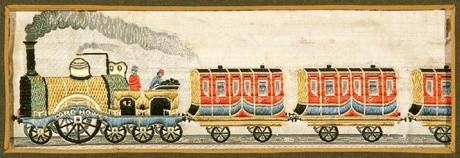B.
Computer art
Behind the scenes
Two works dating from about 1880 can claim to be the earliest computer generated art in the collection.

Thomas Stevens Untitled. Woven silk. Collection of Christchurch Art Gallery Te Puna o Waiwhetū, gifted by Mrs Ethel Horrocks

Thomas Stevens The Present Time, 60 Miles an Hour. Woven silk. Collection of Christchurch Art Gallery Te Puna o Waiwhetū, gifted by Mrs Ethel Horrocks
These woven silk pictures were produced by Thomas Stevens, of Coventry, England as an extension of that city's long established silk ribbon industry. They were produced by transferring drawn designs to a series of punched cards – one card per row of weaving – so several thousand cards were required for each design. The looms followed the instructions on the punched cards over and over again, just like the instructions in a computer programme. This arrangement was not an original invention: the famous Jacquard loom which first used punched cards dates from 1801.
Stevengraphs, as they were called, were immensely popular and were produced as bookmarks, birthday and Christmas cards and as framed mantlepiece decorations. There are hundreds of different subjects, but a regular favourite was the one you see at the top of this page: Lady Godiva riding naked through the streets of Coventry.
Perhaps because they form themselves neatly into sets and categories, and because they can be reliably dated, they are extremely popular with collectors. There are clubs devoted to the hobby of collecting stevengraphs in many countries and they often turn up at auction for very modest prices.

